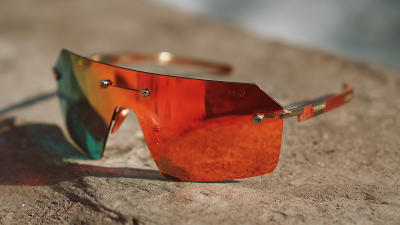As the demand for vision correction increases, progressive lenses have emerged as a popular choice among individuals seeking multifocal solutions without the visible lines associated with traditional bifocals. According to the Vision Council, nearly 65% of adults over the age of 40 experience presbyopia, highlighting a significant market for progressive lenses. However, despite their advantages, wearers often encounter various challenges that can impede their overall satisfaction and usability. This blog will explore common issues such as adaptation difficulties, distortions in peripheral vision, and the learning curve required for optimal usage. Understanding these challenges is crucial, as it can help both consumers and eye care professionals make informed decisions regarding progressive lenses, ultimately improving the wearer's experience.

 Progressive lenses offer a seamless transition between different vision zones, but many users encounter challenges that can hinder their overall experience. One of the most common difficulties is adapting to the lens’ unique design. New wearers often report feelings of distortion or dizziness, particularly when looking down or to the sides. This can stem from the lens’ gradient of refractive power, which requires the eyes and brain to adjust to the varying prescriptions. Finding the right head position for clear vision can be daunting, especially for those who are used to single-vision glasses.
Progressive lenses offer a seamless transition between different vision zones, but many users encounter challenges that can hinder their overall experience. One of the most common difficulties is adapting to the lens’ unique design. New wearers often report feelings of distortion or dizziness, particularly when looking down or to the sides. This can stem from the lens’ gradient of refractive power, which requires the eyes and brain to adjust to the varying prescriptions. Finding the right head position for clear vision can be daunting, especially for those who are used to single-vision glasses.
Another issue often faced by progressive lens users is the narrow field of view. Unlike traditional bifocals, progressive lenses provide a continuous range of vision; however, the sweet spot for clear vision tends to be narrower. This can make activities such as reading or viewing digital screens more challenging, as wearers must learn to shift their gaze appropriately. Additionally, the margin of error in finding that ideal focus can lead to frustration, particularly for users who frequently switch between tasks at different distances. Understanding these common difficulties can help both opticians and wearers address issues and enhance the overall experience with progressive lenses.
Adapting to multifocal vision through progressive lenses can be a significant transition for many wearers. According to the American Optometric Association, about 40% of people between the ages of 40 and 60 require multifocal lenses due to presbyopia, a common age-related vision change. This shift can initially result in discomfort or visual distortion, especially when shifting gaze from distance to near objects. Wearers often report issues with peripheral vision, which is narrower in progressive lenses compared to single-vision glasses. This adjustment phase may take time, typically ranging from a few days to several weeks, as the brain learns to interpret the new visual inputs.
In another report by the Vision Council, it was noted that nearly 70% of progressive lens wearers experience difficulties during the adaptation process. Factors such as the design of the lens, the fitting technique, and even the individual's visual habits contribute to the experience. To ease this transition, optometrists recommend wearing the lenses consistently and providing guidance on proper head movements to maximize the lenses' benefits. This proactive approach can significantly enhance the wearer’s comfort and overall satisfaction with their vision correction solution.
Progressive lenses are a popular choice for individuals requiring multifocal correction, but they often present challenges, particularly regarding visual distortion. Many wearers report experiencing blurriness and edge issues, which can stem from the lens design and the way light passes through different zones. According to a study by the American Optometric Association, nearly 25% of progressive lens users experience significant distortion that affects their daily activities, especially when adapting to new prescriptions or lens types.
To mitigate these challenges, it's essential to select high-quality lenses tailored to individual visual needs. When choosing progressive lenses, look for designs featuring wider reading and intermediate zones to minimize distortion. Innovations in lens technology today allow for customized fitting, which can enhance visual clarity and comfort significantly.
**Tip:** Always consult with a skilled optometrist who can conduct a thorough eye examination and recommend the best progressive lens options, taking into account your unique lens prescription and lifestyle.
Adapting to progressive lenses does take time, but wearers can also ease the transition by practicing eye exercises that help improve focus and minimize eye strain. Watching the horizon, shifting your gaze between close and distant objects, can help train your eyes to use the lenses more effectively.
When selecting frames for progressive lenses, comfort and fitting are paramount for wearers. The choice of frame significantly impacts how users experience progressive lenses, as comfort issues often arise from improper frame design or sizing. For example, studies indicate that visual satisfaction with progressive addition lenses greatly increases when they are prescribed using novel foveal fixation axis measurements, which can ensure that frames align correctly with the wearer’s visual needs. A properly fitting frame can mitigate common challenges faced by users, such as distortion and discomfort when transitioning between different focal points.
Moreover, the rapid growth of online eyewear shopping has transformed how consumers approach their frame selection. With an array of affordable options now available, wearers can prioritize both style and function during their back-to-school shopping. Reports highlight that making informed frame choices can significantly enhance the overall wearing experience of progressive lenses. For instance, a well-designed frame that accounts for face shape and personal comfort can lead to better performance of progressive lenses, minimizing issues typically associated with their use.
| Issue | Impact on Comfort | Frame Material | Adjustment Period |
|---|---|---|---|
| Distortion at the Edges | Can cause dizziness and visual discomfort | Plastic | 1-2 weeks |
| Weight of Frames | Can lead to discomfort and fatigue | Metal | 1 week |
| Frame Fit | Improper fit can affect lens effectiveness | Acetate | Varies |
| Frame Style | Can limit peripheral vision | Combined Material | 2 weeks |
| Lens Height | Too low can affect reading clarity | Lightweight Alloy | 1 week |
Progressive lenses offer a seamless transition for those in need of multifocal vision correction, but many wearers experience initial challenges in adapting to their new eyewear. According to a study by The Vision Council, approximately 50% of first-time progressive lens users report difficulties such as distortion in peripheral vision or issues with finding the right viewing zone. Understanding these challenges is crucial for new wearers, as it can lead to effective strategies for adaptation.

To overcome these challenges, it is important to start gradually. Wearers should spend time adjusting to the lenses in familiar environments before venturing into more complex settings. Experts recommend wearing the progressive lenses at least 6 to 8 hours a day during the initial period to promote adaptation. Additionally, positioning the lenses properly during fitting plays a critical role—an imprecise fitting can lead to increased discomfort and visual disturbances. Data suggests that 70% of progressive lens wearers report greater satisfaction and reduced adaptation time when lenses are precisely fitted. Engaging in open communication with a qualified optician can also provide personalized tips and modifications, ensuring a smoother transition to life with progressive lenses.






